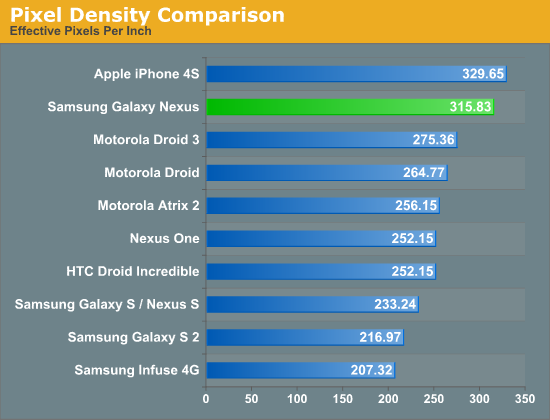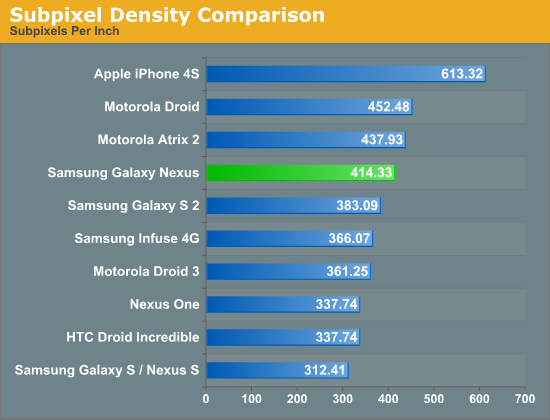Confirmed: Galaxy Nexus Includes PenTile
by Brian Klug & Jason Inofuentes on October 21, 2011 12:58 AM EST- Posted in
- Smartphones
- Samsung
- Ice Cream Sandwich
- Mobile
- AMOLED
- galaxy nexus
Though we've learned a lot about the Galaxy Nexus specifications already, one of the things that has remained a question thus far is whether its 4.65" 720p HD Super AMOLED display uses an RGB subpixel rendering layout or PenTile. We've now confirmed that the Galaxy Nexus display does in fact use RGBG PenTile, like all the Nexus devices to date. This isn't super surprising considering that Samsung has been pretty good about adhering to all the monikers it has gradually been tacking onto AMOLED. There are a number so far - 'super' connotes an optically bonded panel and digitizer stack, 'plus' connotes an RGB stripe, and now 'HD' connotes, well, 720p. HD Super AMOLED lacks Plus, and thus isn't an RGB stripe.
The next question is just what 4.65" HD Super AMOLED will look like, or whether the presence of PenTile will be as noticeable as previous AMOLED phones like the Nexus S / Galaxy S or Nexus One where it was arguably very noticeable. That said, at some subpixel density it should become difficult to impossible to notice PenTile's presence, it's just a matter of exceeding human visual acuity. Having not seen the Galaxy Nexus in person yet and given the absence of good macro shots of the display, we have put together a numerical comparison pitting the Galaxy Nexus panel up against some other common smartphone displays.
First up is a quick plot of the effective pixel density of some popular displays. Stated another way, this is the pixel density based on the manufacturer's stated logical resolution, which is also the resolution of Android's render target for the phone.

Note that this is the traditional means of reporting pixels per inch that we've published before. However, using this metric is just a bit misleading since it doesn't take into account the difference between 2 subpixel-per-pixel RGBG or RBGW PenTile versus the 3 subpixel-per-pixel RGB stripe. To make for an effective comparison, we've put together another plot where we take into account the presence of PenTile and report subpixel density.

Here things still look pretty good for the 4.65" HD Super AMOLED display, putting it just north of SGS2's Super AMOLED Plus display with an RGB stripe. I wager that if you were satisfied with the pixel density of SGS2 that the pixel density Galaxy Nexus actually won't be off-putting despite the presence of PenTile. In addition, hopefully some of the UI design considerations that come along with using PenTile (no vertical 1 pixel thick elements) have been taken into consideration from the outset for Ice Cream Sandwich. For true subjective impressions however, we'll have to wait and see.
Source: Data










152 Comments
View All Comments
Brian Klug - Friday, October 21, 2011 - link
That's part of the job :)You guys keep me on my toes too, which is the awesome part, because sometimes we really do need to be corrected or set straight. I'm not above making mistakes at all, especially trying to calculate subpixel density at 1 AM PST, hahaha
-Brian
Kurian..Of Borg - Friday, October 21, 2011 - link
Scam screen is scam.jalexoid - Friday, October 21, 2011 - link
"Galaxy Nexus display does in fact use RGBG PenTile, like all the Nexus devices to date"Nexus devices usually come in 2 flavours - AMOLED and sLCD. sLCD uses RGB
JasonInofuentes - Friday, October 21, 2011 - link
Both devices, the Nexus One and Nexus S, were introduced with AMOLED screens, the S featuring a SuperAMOLED. Both were eventually sold with sLCD's but his statement still stands, all Nexus devices used RGBG Pentile.tdawg - Friday, October 21, 2011 - link
I'm glad to hear that the Nexus One was a pentile screen. I was getting worried that I was going to have to skip the Galaxy Nexus due to a subpar screen, but I was never dissatisfied with the screen on my N1 so I can't imagine I'll be dissatisfied with the Galaxy Nexus screen.luimana - Friday, October 21, 2011 - link
Thanks for your article Brian and Jason.Just a very small note: iphone 4 ppi is not 329 but 326. The screen infact is not 3.50 inches wide but 3.54
Luigi
orion2001 - Friday, October 21, 2011 - link
I'm still rocking a rooted OG Droid, and I've been looking forward to the Nexus and the RAZR as potential upgrades. However, the second chart in this article is just so damn disappointing. Why have smartphone manufacturers gone backwards with the displays they are using on their phones? I really like the screen on the OG droid, but I would at the very least expect something comparable, if not better out of the latest tech. The higher pixel (sub-pixel) density really makes a big difference when you are trying to read small text on your phone.The Droid does a pretty good job at that, but it is just completely unacceptable for the latest android phones to be going backwards in this department. I've played around with some pentile display phones (I was considering the Droid 3 for upgrade a while back), but I just couldn't stand the screens. I could actually see each pixel quite clearly, and the same webpage looked way clearer on my Droid than the newer phones.
And while AMOLED is nice and all, no one talks about how overly saturated and blown out the colors look on most of these displays. As someone who is into photography and has spent time calibrating his LCD monitors at home, the color accuracy on most AMOLED screens seems extremely poor.
I can't believe that over a year after the whole Retina display hype, android phone manufacturers aren't even anywhere close to playing catchup with Apple on the display side of things. For all the crap Apple got for an incremental upgrade with the 4S, it still seems to beat the latest and greatest android phones on the display and GPU front. I can't stand IOS, and I love android, but I'm just really disappointed with what I'm seeing with the latest and greatest of the new android phones.
dagamer34 - Friday, October 21, 2011 - link
The advancement here is building an OS that supports 1280x720, which actually takes a lot of work to do to look good. The HTC Vigor has a 720p phone thats going to be released soon with a 720p display that's sLCD with an RGB sub pixel layout that'll look far better running ICS than Gingerbread because of the HD screen support.JasonInofuentes - Friday, October 21, 2011 - link
I too share our love for the OG Droid and have only recently retired mine. There's no doubt that we would like to see more advanced displays, the question is cost. The technology to develop IPS displays with high pixel densities and good color characteristic exist, but gets more and more expensive the larger the display. The technology to develop AMOLED displays with high pixel densities and good color characteristics exist . . . with PenTile. Without Pentile there's a matter of mass production readiness. If you want proof that it's still not economically viable, look at LG who introduced their 720p HD display, and then quit the small OLED business completely.In two year we've gone from small (<3.7") LCD's of the TN variety being the only game in town in phones, to much larger (>4.0") LCD's of IPS, TN, sLCD and AMOLED varieties. We are swimming in great screen technology that provides not just great images, but options. Is RGB so important to you? Then go get an SGSII, go get an Atrix 2. If you don't mind small screens, go get an iPhone, or even (as a small upgrade to your phone) a used Droid 2. We've got options, we should enjoy them!
Jason
orion2001 - Friday, October 21, 2011 - link
Jason, I agree with you to some extent, but if the Droid could afford the screen it had...and with all the advancement in display tech in the last 2 years, I just don't see why they are getting away with putting more inferior displays into the phone.And it is even more painful to see, that I can get the Iphone 4S (which has the more expensive components) for $50 less than the Droid Bionic on Verizon. Most likely, the Nexus and RAZR will be even more expensive. If I was your average person who wanted to buy his first smartphone, there is no way I'd pay more for phones that are not close to proven compared to the iPhone. I've accepted that with tablets, it is harder for manufacturers to outcompete Apple on pricing due to the money Apple makes with their appstore. But at least when purchasing a phone, I always assumed that carrier subsidies would price Android and Apple phones equivalently. When the former is cheaper by $100 in comparison to the latest Android phone, you can start to question whether it is worth it.
Make no mistake, I can't stand Apple products, and I will buy an Android phone. But if I was recommending a phone to a friend who wasn't ultra techie, I'd recommend the iPhone 4S for a better phone at a cheaper price.
As for getting the SGSII, I really would...if it ever comes to Verizon. That is the only phone that I have really liked and been impressed by, and it is a shame that even a year down the road, I haven't seen any phone that has taken the next step forward beyond the SGSII.